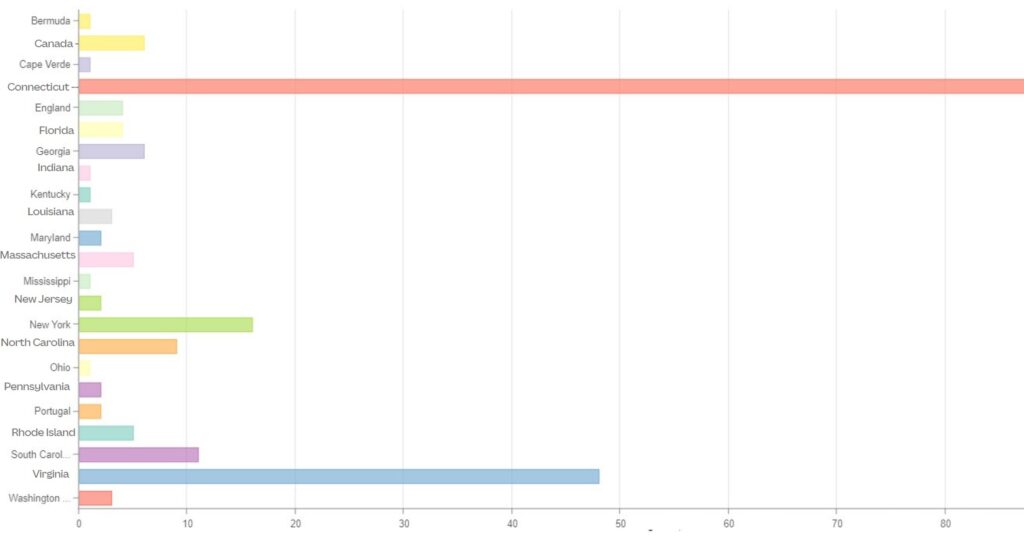New London County Population by Race Taken From Census Information – Social Explorer
1900 (5 to 20 years of age)
White : 97.75% , 22,843
Black : 2.11%, 494
Other Race: .14%, 32
1910
White: 98.32%, 89,717
Black: 1.57%, 1,431
Other Race: .12%, 105
1920
White: 98.5%, 103,045
Black: 1.36%, 1,425
Other Race: .13%, 141
1930
White: 98.49%, 117,165
Black: 1.33%, 1,586
Indian, Chinese, Japanese or other race: .18%, 215
1940
Unclear
1950
Unclear
When the term “historically Black neighborhood” is used, mental maps start to point to blocks in Washington DC, New York, Atlanta, and Detroit. Places with a high urban density attracted migrants from rural areas in a time of the Jim Crow South. It is hard to believe that any state in the North Eastern United States might have a significant enough Black population to have a neighborhood worth of the title of a “historically Black neighborhood.” But, upon research into New London’s Hempstead Street, an interesting pattern emerged.
Of the seventy-eight properties found in Hempstead Street census tracts from 1900-1950, twenty in at least one census had individuals living there with their race marked as Black. And ten of those twenty properties had Black families living there for over half of the surveyed censuses. With just this information, it can seem unclear why Hempstead Street might be known as having a historically Black presence, as uncovered by Maddie Taylor’s thesis. Referencing back to county statistics and comparing to our work, in 1900, 2.11% of the New London county population was marked as Black, which was then noted as being 494 people. On Hempstead Street, forty-one out of 239 people were marked as Black. The percentage of Black indivduals on Hempstead street was 17.15%. This is eight times the county demographics and the trend continues in the following censuses.
Occupants on Hempstead Street
1900
Total Population Recorded: 239
Number of Individuals Recorded as being Black: 41
Number of Black Individuals as a Percent: 17.15%
1910
Total Population Recorded: 307
Number of Individuals Recorded as being Black: 49
Number of Black Individuals as a Percent: 15.96%
1920
Total Population Recorded: 297
Number of Individuals Recorded as being Black: 61
Number of Black Individuals as a Percent: 20.54%
1930
Total Population Recorded: 305
Number of Individuals Recorded as being Black:57
Number of Black Individuals as a Percent: 18.69%
1940
Total Population Recorded: 348
Number of Individuals Recorded as being Black: 45
Number of Black Individuals as a Percent: 12.93%
1950
Total Population Recorded: 260
Number of Individuals Recorded as being Black: 55
Number of Black Individuals as a Percent: 21.15%
Interestingly enough, most of the homes with Black families are clustered together in the same part of the block. When the five Hempstead cottages were first constructed in the 1840s in large part to financial sponsorship by abolitionist Savillion Haley, the Hempstead Street Black community already had roots in this neighborhood and was cemented there with the incentivization of community. From further research, we believe that the area was the location of a number of industrial complexes ranging from a tannery to a weaving and dyeing plant and a laundry facility from the end of the nineteenth to the beginning of the twentieth century. Furthermore, the back of the block facing Franklin Street from 63 to 83 Hempstead held the County Jail, another reason for making the area an undesirable place for families with better financial means, which in New London, unfortunately, meant white, to live. The pattern seen here of housing being available for marginalized identities in an undesirable place for the in-power majority is reminiscent of housing patterns that appeared across the nation.

